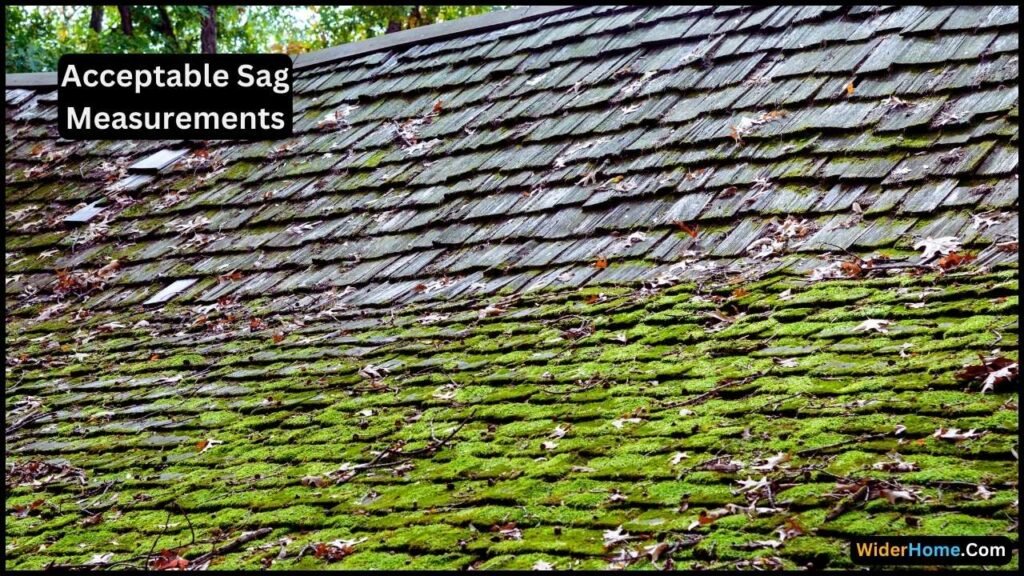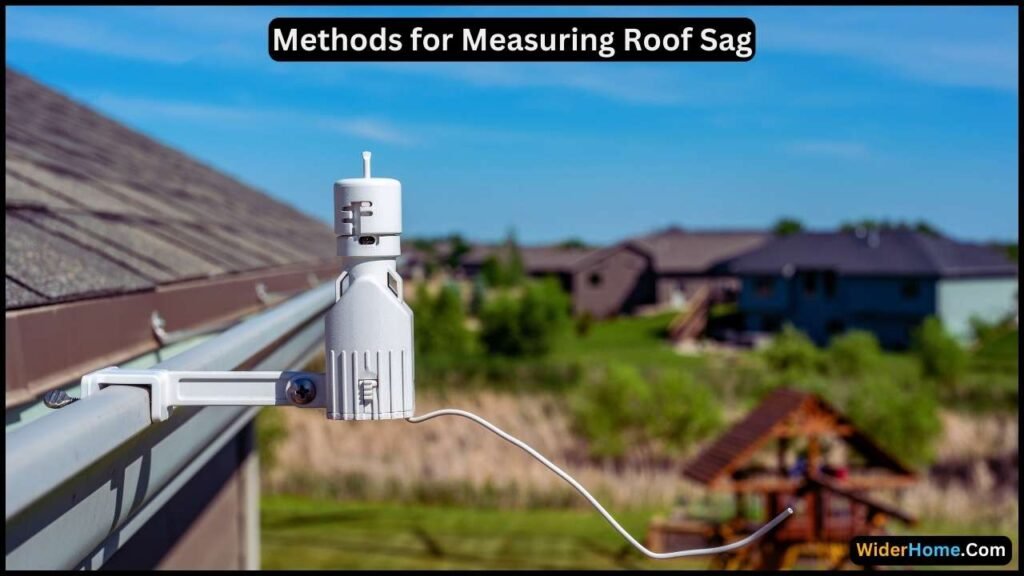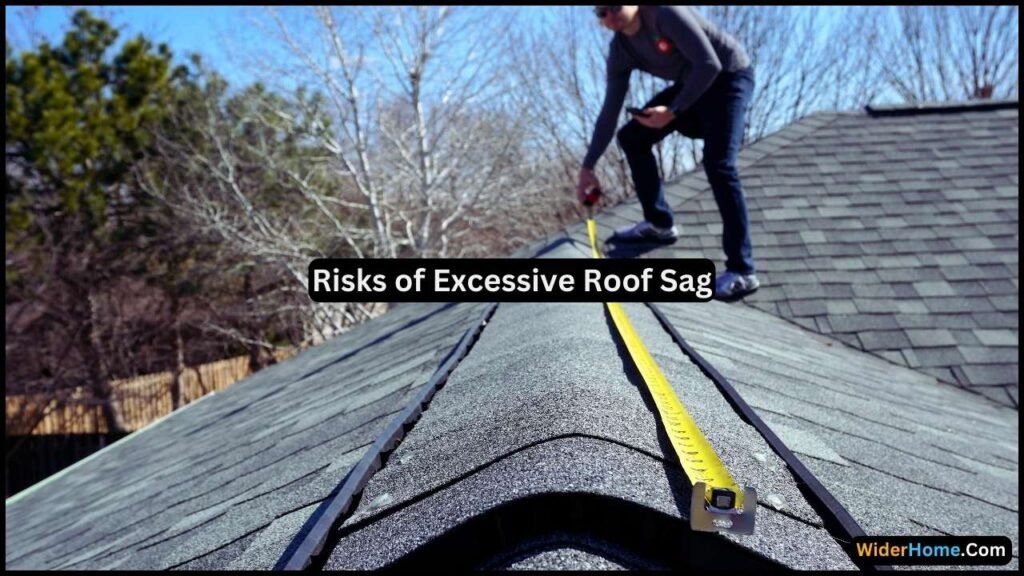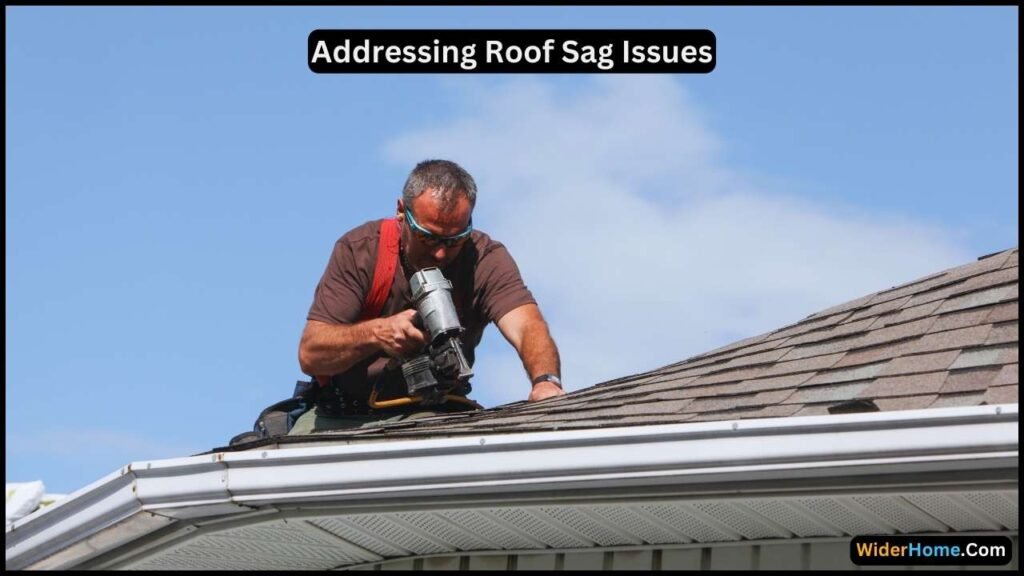How Much Roof Sag Is Acceptable?

The progressive downward curve or dip in a roof is called “roof sag.” Inspecting roof sag is crucial because it might indicate structural problems that, if ignored, could result in more severe damage.
By adopting the required safety measures and being aware of the causes and allowed limits of roof sag, homeowners and builders can maintain the integrity and safety of their roofs.
Causes of Roof Sag
Several factors can cause a roof to sag over time:
- Structural Design Issues: A roof may begin to sag if not engineered to hold the weight it must support. Errors in the original design or construction process may cause this.
- Quality of Materials Used: Sagging may result from improper or low-quality materials used during roof building. A long-lasting, solid roof requires materials that are strong and long-lasting.
- Environmental Factors: A roof may sag over time due to additional pressure from weather events, including heavy snow, strong winds, and prolonged rain.
- Age of the Roof: As a roof age, its components may weaken and decay, causing it to sag. Although normal wear and tear is unavoidable, it can be slowed down with routine maintenance.
After learning about these factors, homeowners can take preventive action to reduce the chance of roof sag and preserve their buildings’ structural integrity.
Industry Standards and Guidelines
Industry standards and guidelines are crucial to guaranteeing roof’s secure construction and maintenance. All construction projects must adhere to the fundamental guidelines provided by building codes and regulations established by municipal authorities.
These codes address several topics, such as the appropriate materials to employ and the maximum degree of permitted roof sag. Roofing experts frequently advise implementing extra best practices to preserve structural integrity and security.
It’s crucial to remember that these requirements may change depending on the kind of roof, such as pitched versus flat roofs. Adhering to these recommendations ensures the longevity and safety of the structure by preventing severe problems related to roof sag.
Acceptable Roof Sag Measurements

Determining acceptable sag measurements for a roof depends on various factors, including the type of roof and its usage. Here is a simple guide:
General Acceptable Sag Limits
Generally, a roof’s sag should be at most 1/4 inch per 20 feet of length. If the sag is more significant, it might indicate structural concerns that must be addressed.
Residential vs. Commercial Roofs
Due to their design and load-bearing requirements, residential roofs typically have a lower tolerance for sag than commercial roofs. Therefore, any noticeable sag in a residential roof should be inspected promptly.
Flat Roofs
Flat roofs need to remain as level as possible. A slight sag is more noticeable and potentially problematic because it can lead to water pooling, which risks leaks and water damage. A sag greater than 1/8 inch per foot in flat roofs should raise concern.
Sloped Roofs
Sloped or pitched roofs can handle more variation. However, a sag greater than 1/2 inch over 10 feet of a roof’s length could indicate potential structural issues and should be examined by a professional.
Considering these measurements, regular inspections and timely maintenance are critical in preventing excessive sag and ensuring the roof remains safe and functional.
Methods for Measuring Roof Sag

Measuring roof sag ensures your home’s safety and structural integrity. Here are some easy-to-follow methods:
Visual Inspection Techniques
Start by observing the roof from a distance. Look for any noticeable dips or curves in the roofline. To identify any variations in height, use a straight edge or a string line across the roof’s surface. If the roof appears uneven or has noticeable sags, it could indicate structural issues.
Laser Levelers
A laser leveler projects a straight line across the roof surface, making it easy to identify any sagging areas. Place the laser leveler on one end of the roof and point it towards the other; any deviations in the laser line indicate sag.
Measuring Tapes
A measuring tape can be used to check the height difference between the edges and the middle of the roof. Mark a point at each edge and the center, then measure the distance from the ground to each end. A significant height difference at the center suggests sagging.
Levels
A traditional bubble level can also be helpful. Place it at various points along the roof’s surface to check for levelness. Any deviation of the bubble from the center indicates sag.
When to Call a Professional
If you are unsure about your measurements or suspect a serious problem, it is best to call a roofing professional. They have the specialized tools and expertise to assess roof sag accurately. If excessive sag is detected, professionals can inspect thoroughly and recommend appropriate remediation measures.
Risks of Excessive Roof Sag

A roof that dips too much might be hazardous for several reasons. First, a sagging roof may indicate weakening and eventually collapse, endangering or perhaps killing someone within the house.
Secondly, water can seep through cracks and holes in a sagging roof. Water can harm your personal belongings and the walls and ceilings. Over time, it has the potential to produce mold, which is unhealthy and can make you sick.
Third, the walls and foundation of the house are under increased stress due to a sinking roof. This may result in costly-to-fix fractures and other issues.
Last but not least, a sagging roof detracts from the appearance of your home and may even reduce its worth. If you’re trying to sell your house, a sagging roof may turn potential buyers away since they’ll assume it requires costly repairs.
Addressing Roof Sag Issues

Addressing roof sag issues promptly is essential to maintaining your home’s structural integrity and safety. Here are the steps involved in tackling roof sag:
Initial Assessment
Begin with a thorough inspection to determine the extent of the sag and identify any underlying causes. This could involve checking for water damage, compromised structural components, or issues with the roofing materials.
Consult a Professional
If the sag is significant or you suspect structural damage, it is crucial to consult a roofing professional. They can provide a detailed assessment and recommend the most appropriate remediation measures.
Professionals have the expertise and tools to diagnose problems accurately and propose lasting solutions.
Repair Damaged Areas
Depending on the cause of the sag, repairs include replacing damaged or weakened rafters, adding new supports, or repairing the roof decking.
Addressing water damage typically involves fixing leaks, replacing rotten wood, and ensuring proper drainage to prevent future issues.
Reinforce the Structure
When the roof structure is compromised, reinforcing the affected areas is necessary. This could involve installing additional bracing, sistering existing rafters, or adding a support ridge beam. Strengthening the structure helps distribute weight evenly and prevents future sagging.
Regular Maintenance
Ongoing maintenance is vital in preventing roof sag from reoccurring. This includes regular inspections, cleaning gutters, ensuring proper attic ventilation, and promptly addressing any minor issues before they escalate.
Keeping the roof in good condition helps prolong its lifespan and maintains the overall stability of your home.
Consider Roof Replacement
In severe cases where repairs are insufficient to address the sag, replacing the entire roof might be necessary. While this is a more costly and extensive measure, it ensures long-term safety and functionality.
A new roof also allows upgrading materials and design for better performance and durability.
Preventing Future Roof Sag

Keeping your roof from sagging in the future is essential for your home’s safety. Here are some simple steps you can take:
- Regular Inspections: Check your roof often to spot problems early. Look for missing shingles, leaks, or any areas that seem to be sagging.
- Clean Gutters: Ensure your gutters are clean so water can flow away from your roof. Clogged gutters can cause water to build up and damage your roof.
- Proper Ventilation: Ensure your attic has good ventilation. This helps keep the temperature steady and prevents moisture buildup, which can weaken the roof.
- Fix Minor Issues Quickly: If you notice any small problems, immediately fix them. This stops them from turning into more significant, more expensive issues.
- Trim Overhanging Branches: Trees that hang over your roof can drop leaves and branches, damaging the roof. Keep branches trimmed to prevent this.
- Distribute weight Evenly: If you need to place something heavy on your roof, spread the weight evenly. Too much weight in one spot can cause the roof to sag.
- Consult a Professional: Have a roofing expert look at your roof every few years. They can spot problems you might miss and advise you on keeping it in good shape.
Following these steps can help stop your roof from sagging and keep your home safe and sturdy.
FAQs (How Much Roof Sag Is Acceptable)
How Much Ceiling Sag Is Acceptable?
A slight ceiling sag is often okay, especially in older homes where the structure might settle slightly over time. However, significant or noticeable sags should be checked out by a professional. They can determine whether a more severe issue needs to be addressed. To be cautious, it’s worth having it checked out if the sagging is more than 1/2 inch.
How do I measure roof sag?
Measure the amount of roof sag by laying a level or a long, straight edge horizontally across the suspected drooping region. The vertical distance between the straight edge and the sag’s lowest point should be measured. This can help you determine how much the sagging is.
What is the maximum acceptable amount of roof sag?
Less than 1/4 inch of sag is generally considered acceptable for roof sag for every foot of horizontal span. When the sag exceeds this threshold, it is deemed severe and calls for additional research and possible repair.
Can I ignore a slight roof sag if it’s not causing any leaks?
Even in the absence of leaks, giving special attention to any slight dip in the roof is crucial. Over time, minor sags may worsen and lead to more significant structural problems if they are not corrected. Frequent checks can give peace of mind and assist in identifying any advancement of the sag.
What are the common causes of roof sag?
Many things can lead to a sagging roof, such as water damage, snow or ice accumulation that weighs too much, shoddy construction, rotten or inadequate beams, and aging-related wear and strain. Finding the underlying problem is essential to successful prevention and repair.
Should I consult a professional if I notice a roof sag?
Speaking with a roofing contractor is always a good idea if you observe any roof droop. Experts have the knowledge and resources necessary to precisely evaluate the state of your roof and suggest the best course of action for resolving any problems.
Can reinforcing my roof prevent future sagging?
You can avoid future drooping and help distribute the weight more evenly by reinforcing your roof with additional support, like bracing or sistering rafters. Experts in roofing can guide you in the most effective ways to strengthen your roof’s structure.
Will roof sag affect my home’s resale value?
Significant roof sag might lower the value of your house when you sell it, as buyers might think it’s a sign of structural problems or needing repairs. Promptly addressing and repairing roof sag can help preserve or even increase the market value of your house.
Conclusion
Keeping your roof in good condition is essential to preserving the stability and security of your home. A drooping roof can cause many expensive problems as well as be dangerous. Regular roof inspections, quick fixes for little issues, and expert roofing help can all help prevent your roof from sagging. You preserve your home’s value, safety, and appeal in this way. Recall that everyone residing within the building is likewise protected by a well-maintained roof.
